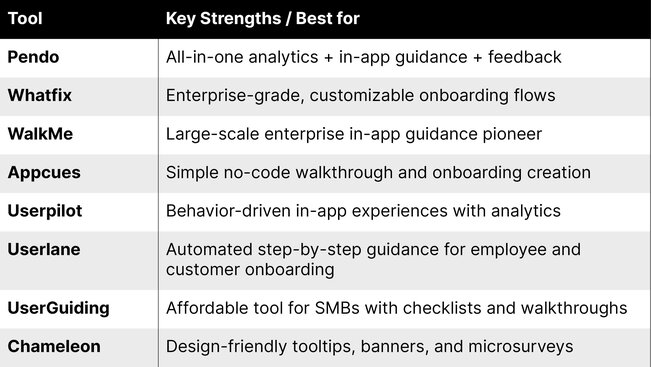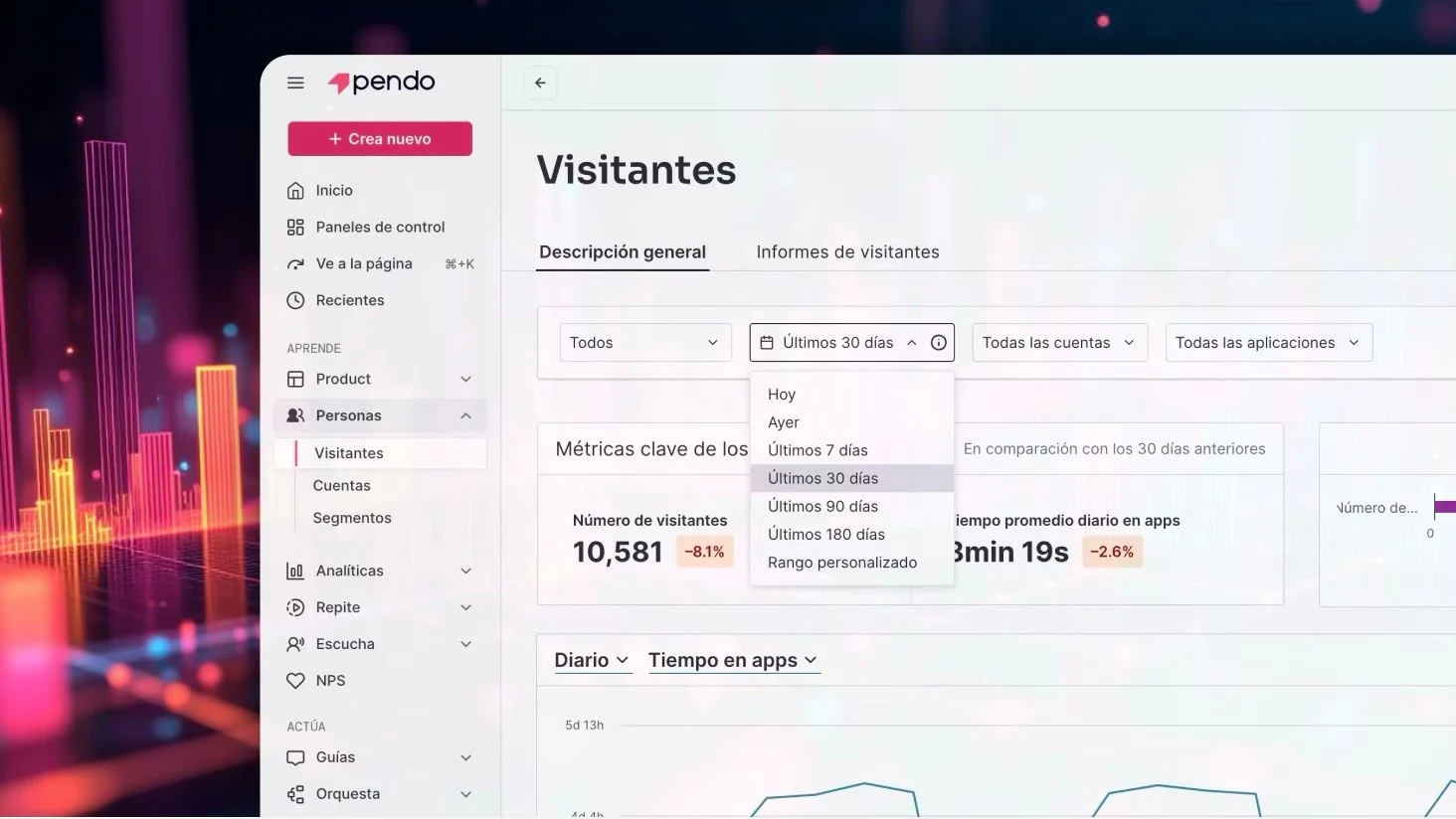Nobody reads manuals anymore. Instead, users expect instant, in-product support when and where they need it. In-app guidance delivers just that.
Whether they’re external customers or internal employees, in app tools empower users to navigate confidently and get more value from software platforms. How? By providing timely help, contextual tips, and proactive support as they explore the application. These in app guide tools replace outdated training methods with a faster, smarter, more effective approach.
Below, we’ll take you through the top 8 in‑app guidance tools available in 2025, from Pendo’s analytics‑infused platform to specialist alternatives. You can choose the right solution for your business, based on feature needs, scalability, and budget.
In this era of rapid digital transformation, engaging and effectively onboarding users is key to business success. That’s why tools like Pendo, tools that can deliver real-time assistance and drive product adoption, are no longer nice-to-have. They’re essential.
What makes an in-app guidance tool effective?
Great in-app guidance tools go beyond delivering information. They drive tangible user and business outcomes through a blend of core and advanced features. Crucially, they’re also easy to use.
Core capabilities
The foundation of any effective in-app guidance tool is its ability to deliver essential messages in a variety of formats. Let’s look at their core capabilities:
Onboarding flows & walkthroughs: Multi-step guides that lead users through a process, helping them with initial setup or new feature adoption.
Tooltips: Brief, contextual messages anchored to a specific user interface (UI) element, providing subtle hints or answering common questions.
Checklists: Interactive to-do lists that break down complex workflows into a structured, step-by-step format.
Advanced capabilities
Now, let’s move beyond the basics. Advanced tools provide a strategic advantage. These features enable a more intelligent, personalized, and proactive user experience.
Personalization & segmentation: The ability to target specific user cohorts based on roles, tenure, or behavioral data ensures the right person receives the right message at the right time.
Contextual triggers: In app guides that are triggered by a user's real-time actions, rather than being manually deployed, provide immediate, relevant assistance.
Analytics integration: A crucial feature that allows teams to measure the effectiveness of their guides, identify friction points, and continuously optimize the user experience.
Ease of use
The best in app tools are intuitive. They empower non-technical teams to create and deploy guides without writing a single line of code.
This no-code approach and cross-platform compatibility allows product, marketing, and success teams to move quickly and iterate based on real-time data.
The best in-app guide tools seamlessly combine in-app guidance with analytics and feedback. This creates a powerful loop that informs and improves the entire user experience.

Let’s take a closer look
Each in app tool delivers value. But to make the right choice for your business, you need to understand their individual strengths.
Here, we review the top eight solutions and highlight Pendo’s unmatched leadership in Software Experience Management (SXM).
Pendo: The clear leader in in-app guidance
Pendo is the definitive leader for in-app guidance. Why? Because it’s the only platform that combines powerful product analytics with intuitive in-app guides and feedback collection.
The Pendo platform is built on the premise that you cannot effectively guide users without first understanding their behavior. This intelligence is the foundation of the Pendo experience, setting it apart from competitors who primarily focus on the mechanics of building guides.
Key features & strengths: Pendo provides a Product Engagement Score (PES) – a metric that provides a singular view into how users are interacting with your product.
The platform’s no-code visual designer allows anyone on a team to build tailored in-app guidance without engineering support , from simple tooltips to multi-step walkthroughs.
Pendo also enables users to personalize every experience. By segmenting and targeting guides to specific user cohorts based on roles, tenure, or other behavioral data.
Best for: SaaS companies of all sizes that need a comprehensive platform to understand user behavior and deliver in-app guidance that directly impacts revenue, efficiency, and customer loyalty.
Comparison to competitors: While some competitors may excel in specific areas, none match Pendo's all-in-one integration of analytics, guidance, and feedback.
Pendo's platform creates a self-reinforcing feedback loop where teams can identify friction points with analytics, deploy a data-informed solution with guides, and measure the impact in real-time.
2. Whatfix: Enterprise customization
Whatfix is a full-featured Digital Adoption Platform (DAP). It is designed for large enterprises that need to roll out and support internal tools like CRMs, ERPs, or HR platforms. The platform is known for providing interactive, customizable onboarding flows and is used for employee training, enablement, and change management.21
Key features & strengths: Whatfix provides interactive walkthroughs (Flows), contextual tooltips (Smart Tips), and interactive checklists (Task Lists) to accelerate user learning and reduce drop-off. It also offers multi-language support and self-help modules.
Best for: Whatfix is best for large enterprises that need highly customizable, scalable solutions for complex onboarding and internal process compliance.
Comparison to Pendo: While WhatFix offers strong customization, it lacks robust product analytics capabilities and is often seen as more complex than Pendo's integrated solution.
3. WalkMe: Pioneer in in-app guidance
WalkMe is a leading Digital Adoption Platform (DAP) tailored for large enterprises. It is considered a pioneer in the in-app guidance space, providing real-time, on-screen help to streamline the learning process and reduce the need for traditional training.
Key features: Advanced onboarding, employee training including Smart Walk-Thrus and SmartTips for contextual guidance. UI Intelligence provides user behavior analysis to identify areas of friction.
Best for: Large-scale digital transformation and change management initiatives. It's ideal for enterprises that need to manage complex, company-wide software rollouts.
Comparison to Pendo: WalkMe has a strong enterprise presence but is often described as resource-intensive to deploy and maintain. Its overlays can also lead to "guide fatigue".
Pendo, in contrast, provides a more agile and integrated approach to both analytics and guidance, offering a unified platform for both external and internal use cases.
4. Appcues: Simple no-code walkthrough and onboarding creation
Appcues is a cloud-based, no-code platform that specializes in creating in-app user journeys and product tours.
It’s highly regarded for its intuitive, drag-and-drop builder. Making it an ideal solution for non-technical teams, such as marketers and product managers, who can quickly build and launch engaging user experiences without relying on developers.
Key features: Easy-to-use drag-and-drop builder, onboarding flows, and in-app surveys like NPS.
Best for: Product teams that need to get started quickly with simple product tours and basic onboarding. It's particularly well-suited for early-stage and mid-market SaaS companies.
Comparison to Pendo: Appcues is simple to use and excels as an entry point for basic onboarding. But it lacks the depth of analytics and the comprehensive platform that Pendo offers.
Pendo empowers teams to understand the behavioral data that should inform their guides. It also allows for the continuous optimization of the entire user journey, going far beyond simple tours to drive adoption and retention at scale.
5. Userpilot: Behavior-driven experiences
Userpilot is a platform designed for product-led growth (PLG) teams, with a strong focus on creating personalized, in-app experiences and leveraging product analytics.
Key features: The platform offers a no-code builder for interactive guides and checklists, and robust user segmentation for personalized onboarding.
Best for: Early stage startup companies looking for easy-to-use solutions for their onboarding needs.
Comparison to Pendo: Userpilot is great for making data driven decisions around basic onboarding, Pendo is a more robust and scalable platform that acts as a deeper "system of record" for product usage data.
6. Userlane: Automated guidance
Userlane is an automated training and user onboarding tool that records on-screen actions and turns them into interactive, step-by-step guides.
Key features: Ability to create interactive guides and automated flows for training and support. It also offers user segmentation and targeting to provide contextual support and has multi-language support to reach a global audience.
Best for: Simple training purposes, such as employee onboarding and customer support, to help users master new tools and processes.
Comparison to Pendo: Userlane is strong for internal enablement and employee training. But Pendo’s better suited for holistic product adoption and advanced analytics.
Userlane's analytics are often considered less comprehensive than Pendo’s and may require integrations with external tools for deeper analysis.
7. UserGuiding: Affordable walkthrough software
UserGuiding is an accessible user onboarding platform that helps SaaS businesses create interactive onboarding experiences, product tours, and checklists.
Key features: A suite of essential onboarding tools, including interactive product walkthroughs, onboarding checklists, a Resource Center, and NPS surveys.
Best for: Small businesses and startups that need to implement basic onboarding flows and guides without the complexity or high cost of enterprise-grade platforms.
Comparison to Pendo: While UserGuiding provides a cost-effective entry point, it lacks the depth of analytics, security, and scalability that Pendo offers.
8. Chameleon: Design-friendly in-app guidance
Chameleon is a product adoption platform known for its focus on design flexibility and building in-app experiences using a variety of formats – including embeddable cards and pop-up modals. It allows teams to create step-by-step checklists, walkthroughs, and contextual nudges.
Key features: Embeddables allow for in-line banners and embedded cards that can be customized with visuals and videos. The platform also offers microsurveys, launchers, A/B testing, and localization features.
Best for: Design-heavy teams that prioritize a flexible and aesthetic user experience.
Comparison to Pendo: While Chameleon's design strengths are valuable, the platform is known to have a steep learning curve and its analytics and segmentation capabilities can be limited.
Everything that sets Pendo apart
In an increasingly crowded market, Pendo leads the way by offering a unique and comprehensive solution that few can match.
A seamless, integrated approach
While competitors may excel in specific areas – be it enterprise-level customization (Whatfix), no-code simplicity (Appcues), or design flexibility (Chameleon) – none provide Pendo's seamless and integrated approach.
A cycle of continuous improvement
Pendo is the only platform that combines product analytics, in-app guidance, and feedback into a single, cohesive system. This unique blend enables product teams to not just guide users, but to measure and improve adoption continuously.
Scalable for every business
Pendo’s data-first approach allows teams to identify user friction points, deploy targeted solutions, and then measure the impact in real-time – creating a virtuous cycle of improvement. This capability is scalable and effective for companies of all sizes, from growing startups to large enterprises.
Choosing the right in-app guidance tool for your business
Choosing the right tool is a strategic decision that depends on your specific needs. When evaluating solutions, there are a number of factors to consider. Let’s take a look.
Business size
Are you a small team looking for an affordable, entry-level option, or a large enterprise with complex, custom requirements?
Need for analytics vs. pure onboarding
Do you need a simple tool to create walkthroughs, or a platform that provides deep, actionable insights into user behavior?
If analytics are a top priority, Pendo’s integrated platform is the clear choice.
Integration with existing tools
Does the platform integrate seamlessly with your current tech stack, including your CRM, analytics tools, and marketing automation software?
A platform that works well with your existing systems can provide a much higher return on investment.
For teams that need a complete product experience solution – one that provides deep analytics, seamless guidance, and robust feedback – it has to be Pendo.
Top tips for implementing in-app guidance
Once you've chosen a tool, you need to think carefully about how you implement it. Here are some best practices to follow.
Start with clear goals
Before building guides, define what you want to achieve, whether it's faster onboarding, increased feature adoption, or a reduction in support tickets.
Keep guides simple and contextual
Walkthroughs should be concise and focused, ideally 5-7 steps. Deliver help at the precise moment a user needs it, not as an overwhelming, upfront tutorial.
Use segmentation to personalize experiences
Tailor your guidance to specific user segments – based on their roles, behavior, or other metadata – to ensure content is always relevant and helpful.
Continuously measure and iterate
Use analytics to track guide completion rates, drop-offs, and user feedback. Use this data to refine your guides and improve their effectiveness over time.
How to implement in-app guidance
Follow this checklist to build effective in-app guides:
Define a measurable goal: Set clear objectives such as increasing feature adoption or reducing onboarding time. Goals provide benchmarks to measure success and justify investment.
Instrument guide analytics: Track views, completion rates, drop-offs, and conversions. Analytics show where users succeed or struggle, making it possible to improve guides.
Configure audience segments and triggers: Use segments and real-time conditions to deliver targeted experiences. Relevance increases engagement and ensures the right users see the right guidance.
Keep copy short and contextual: Write concise text and localize where needed. Clarity and localization reduce confusion and improve user comprehension.
Use themes and categories: Organize guides with governance features. Categorization keeps large content libraries manageable and scalable.
Run A/B tests: Experiment with variations and refine under-performing guides. Testing validates effectiveness and helps identify the most impactful guidance.
Extend across apps and mobile: Deliver guidance consistently across all environments. Consistency ensures users have a seamless experience no matter the platform.
Why Pendo has the edge
In-app guidance is no longer a luxury. It’s a necessity. A must for any business looking to accelerate product adoption and drive user success.
Gartner predicted that by 2025, 70% of organizations would use DAPs to fix poor user experiences. That future’s here. Software is now centered on intuitive, seamless user experiences that empower customers and employees alike.
As the market shifts toward a more intelligent, AI-driven future, it’s vital that you have a platform that can combine data and guidance. Pendo’s unique blend of product analytics and in-app guidance makes it the most complete and future-proof solution on the market.
Pendo’s built to be a "tech stack's system of record" for AI, SaaS, and agents. It provides the secure and compliant data backbone needed to refine user experiences and empower the autonomous, agentic workforce of tomorrow.
With the ability to automatically suggest resources based on user behavior and provide predictive insights into user churn and conversion, Pendo gives product teams a definitive strategic advantage.
Ready to see how Pendo can help you improve your user experience and drive product adoption? Schedule a live demo or start your free trial today, and see for yourself why Pendo is the leading choice for in-app guidance and beyond.
![[object Object]](https://cdn.builder.io/api/v1/image/assets%2F6a96e08774184353b3aa88032e406411%2F8472924f687a4c359fb61b69d3ac4ea4?format=webp)



